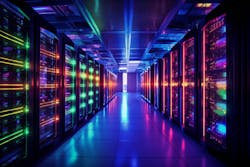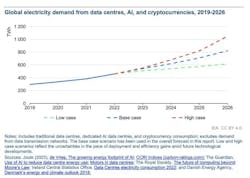IEA Study Sees AI, Cryptocurrency Doubling Data Center Energy Consumption by 2026
This article originally appeared in Data Center Frontier's sibling publication, Lightwave, a chronicler of the fiber-optic telecommunications, networking and optoelectronics sectors.
Data centers have the potential to double their energy usage by 2026, according to a recent International Energy Agency (IEA) report.
IEA forecasts that data centers’ total electricity consumption could reach more than 1,000 terawatt-hours (TWh) in 2026.
“This demand is roughly equivalent to the electricity consumption of Japan,” said the report. “Updated regulations and technological improvements, including on efficiency, will be crucial to moderate the surge in energy consumption from data centers.”
In 2022, 460 terawatt-hours (TWh) was consumed by data centers, representing two percent of all global electricity usage.
Within the data center segment, IEA wrote that computing power and cooling were the two most energy-intensive processes within data centers.
Additionally, the report noted how the rapid growth of artificial intelligence-related services over the last 12 months means providers have invested in power-hungry GPUs.
How AI, Cryptocurrencies Will Tighten the Data Center Energy Crunch
Looking into how AI and cryptocurrencies, hosted inside data centers, are raising energy consumption, the IEA said that taken together, both technologies will double facilities' electricity usage by 2026.
What will drive AI’s usage trends is that as AI gets incorporated into software programming in various sectors, it will increase the overall electricity demand of data centers.
For example, the study forecasts that search engine sites like Google could witness a tenfold increase in electricity demand when AI is fully implemented on their platform.
“When comparing the average electricity demand of a typical Google search (0.3 Wh of electricity) to OpenAI’s ChatGPT (2.9 Wh per request), and considering 9 billion searches daily, this would require almost 10 TWh of additional electricity in a year," observed the report.
IEA added, "AI electricity demand can be forecast more comprehensively based on the number of AI servers estimated to be sold and their rated power.”
The report noted how NVIDIA continues to lead the AI server market, which has a 95% market share. Last year, NVIDIA shipped 100,000 units that consume an average of 7.3 TWh of electricity annually.
IEA said that by 2026, the AI industry is expected to have grown exponentially to drink at least ten times its demand in 2023.
Meanwhile, the report found that cryptocurrencies consumed about 110 TWh of electricity in 2022, accounting for 0.4% of the global annual electricity demand. IEA forecast that the electricity consumption of cryptocurrencies will increase by more than 40% to around 160 TWh by 2026.
Bitcoin and Ethereum: Efficiency Challenges
Additionally, the study highlighted differences and technology efficiency challenges amongst the leading cryptocurrency platforms—Bitcoin and Ethereum.
The study found Ethereum reduced its electricity demand by 99% in 2022 by changing its mining mechanism, while Bitcoin is estimated to have consumed 120 TWh by 2023, contributing to a total cryptocurrency electricity demand of 130 TWh.
“Challenges in reducing electricity consumption remain, as energy savings can be offset by increases in other energy consuming operations, such as other cryptocurrencies, even as some become more efficient,” the IEA study said.
US Data Center Market Surge
From a regional perspective, IEA found over 8,000 data centers globally: 33% in the U.S., 16% in Europe, and almost 10% in China.
IEA estimates that the U.S. data center's electricity consumption rate will rise from about 200 TWh in 2022 to almost 260 TWh in 2026, accounting for 6% of total electricity demand.
This growth will result from the ongoing adoption of 5G wireless networks, cloud-based services, and competitive state tax incentives.

Sean Buckley
Sean Buckley is Editor in Chief of Endeavor Business Media's Lightwave, responsible for establishing and executing editorial strategies across the publication's websites, email newsletters, events, and other information products.






